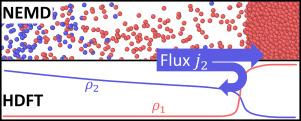基于水动力密度泛函理论的汽液界面传质
IF 5.8
2区 工程技术
Q1 ENGINEERING, MECHANICAL
International Journal of Heat and Mass Transfer
Pub Date : 2025-10-17
DOI:10.1016/j.ijheatmasstransfer.2025.127874
引用次数: 0
摘要
我们通过研究初始平衡纯组分汽液系统对第二组分局部插入的响应,评估了水动力密度泛函理论(水动力DFT)预测汽液界面传质的能力。水动力DFT通过在经典DFT基础上对非均匀体系的化学势梯度进行建模来捕捉界面对动力学的影响。流体动力学DFT有效地将分子模型与连续流体动力学联系起来。离开界面,框架简化为等温Navier-Stokes方程。我们采用广义驱动力的麦克斯韦-斯蒂芬扩散来模拟非均匀系统中的扩散分子输运。对于考虑的Lennard-Jones截断移位(LJTS)流体,我们使用了基于摄动截断移位(PeTS)状态方程的非局部亥姆霍兹能量泛函。该模型为界面附近LJTS流体的等温传质提供了无噪声的部分密度和通量,以及这些量在界面上的分布。与非平衡分子动力学模拟的比较表明,流体动力学DFT准确地预测了通过界面的传质,包括界面上轻沸组分的暂时富集和排斥等微观现象。将广义熵标度与广义麦克斯韦-斯蒂芬扩散相结合,可以准确地描述系统中的扩散分子输运。这种方法准确地捕捉相行为,平衡界面,以及通过基于分子相互作用的界面的质传递,用于强不同组分的混合物。我们的结果表明,流体动力DFT可以准确地预测气液界面混合物的动力学。这对于模拟流体系统和多孔介质中的传输过程非常重要,特别是对于描述孔隙的蒸发,这需要精确模拟通过汽液界面的传质。本文章由计算机程序翻译,如有差异,请以英文原文为准。

Mass transfer through vapor–liquid interfaces from hydrodynamic density functional theory
We assess the capabilities of hydrodynamic density functional theory (hydrodynamic DFT) to predict mass transfer through vapor–liquid interfaces by studying the response of an initially equilibrated pure component vapor–liquid system to the localized insertion of a second component. Hydrodynamic DFT captures the effect of interfaces on the dynamics by modeling the chemical potential gradients of an inhomogeneous system based on classical DFT. Hydrodynamic DFT effectively connects molecular models with continuum fluid dynamics. Away from interfaces the framework simplifies to the isothermal Navier–Stokes equations. We employ Maxwell–Stefan diffusion with a generalized driving force to model diffusive molecular transport in inhomogeneous systems. For the considered Lennard–Jones truncated and shifted (LJTS) fluid, we utilize a non-local Helmholtz energy functional based on the perturbed truncated and shifted (PeTS) equation of state. The model provides noise-free partial densities and fluxes for the isothermal mass transfer of a LJTS fluid near the interface, as well as profiles of these quantities across the interface. A comparison with non-equilibrium molecular dynamics simulations shows that hydrodynamic DFT accurately predicts mass transfer through the interface, including microscopic phenomena such as the temporary enrichment and repulsion of the light-boiling component at the interface. Combining generalized entropy scaling with generalized Maxwell–Stefan diffusion allows for an accurate description of diffusive molecular transport in the system. This approach accurately captures phase behavior, equilibrium interfaces, and mass transfer through interfaces based on molecular interactions for mixtures of strongly dissimilar components. Our results suggest that hydrodynamic DFT accurately predicts the dynamics of mixtures at vapor–liquid interfaces. This is important for modeling transport processes in fluid systems and porous media — particularly for describing evaporation from pores, which requires accurate modeling of mass transfer through vapor–liquid interfaces.
求助全文
通过发布文献求助,成功后即可免费获取论文全文。
去求助
来源期刊
CiteScore
10.30
自引率
13.50%
发文量
1319
审稿时长
41 days
期刊介绍:
International Journal of Heat and Mass Transfer is the vehicle for the exchange of basic ideas in heat and mass transfer between research workers and engineers throughout the world. It focuses on both analytical and experimental research, with an emphasis on contributions which increase the basic understanding of transfer processes and their application to engineering problems.
Topics include:
-New methods of measuring and/or correlating transport-property data
-Energy engineering
-Environmental applications of heat and/or mass transfer

 求助内容:
求助内容: 应助结果提醒方式:
应助结果提醒方式:


